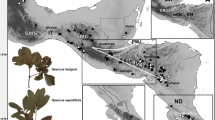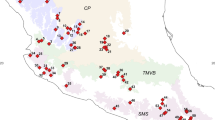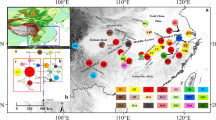Abstract
Orographic and climatic influences during the Pleistocene have had a crucial role on interspecific divergence and population demography during speciation. However, associations between demographic histories of closely related species and related climatic events, especially in north and northeast China, are still underexplored. Genetic analyses with four chloroplast DNA and two nuclear genes and species distribution modeling were used for two closely related oak species (Quercus liaotungensis and Quercus mongolica) to test if their interspecific divergence and phylogeographical histories were possibly related to the Pleistocene-era climatic events. Potential divergence of the two oak species was estimated at about 0.92–2.15 Ma. Species distribution models and genetic data showed varying phylogeographical histories and spatial population structures between the two oaks, leading to different patterns of interspecific gene flow between the chloroplast and nuclear genes. The results indicate that speciation event between the two species is recent and may have been triggered by geological and climatic fluctuations linked to the upheavals of the Qinghai-Tibetan Plateau at the Pliocene/Pleistocene boundary. The two closely related oaks possess varying population demography during the interglacial-glacial climatic oscillations of the Quaternary, probably due to the various niche adaptations among different distribution ranges across their species trajectories.




Similar content being viewed by others
References
Abadie P, Roussel G, Dencausse B, Bonnet C, Bertocchi E, Louvet JM, Kremer A, Garnier-Gere P (2012) Strength, diversity and plasticity of postmating reproductive barriers between two hybridizing oak species (Quercus robur L. and Quercus petraea (Matt) Liebl.). J Evol Biol 25:157–173
Alexander LW, Woeste KE (2014) Pyrosequencing of the onrthern red oak (Quercus rubra L.) chloroplast genome reveals high quality polymorphisms for population management. Tree Genet Genomes 10:803–812
Bai WN, Liao WJ, Zhang DY (2010) Nuclear and chloroplast DNA phylogeography reveal two refuge areas with asymmetrical gene flow in a temperate walnut tree from East Asia. New Phytol 188:892–901
Bandelt HJ, Forster P, Rohl A (1999) Median-joining networks for inferring intraspecific phylogenies. Mol Biol Evol 16:37–48
Beerli P, Felsenstein J (2001) Maximum likelihood estimation of a migration matrix and effective population sizes in n subpopulations by using a coalescent approach. Proc Natl Acad Sci 98(8):4563–4568
Cavender-Bares J, Gonzalez-Rodriguez A, Eaton DAR, Hipp AAL, Beulke A, Manos PS (2015) Phylogeny and biogeography of the American live oaks (Quercus subsection Virentes): a genomic and population genetics approach. Mol Ecol 24:3668–3687
Cavender-Bares J, Gonzalez-Rodriguez A, Pahlich A, Koehler K, Deacon N (2011) Phylogeography and climatic niche evolution in live oaks (Quercus series Virentes) from the tropics to the temperate zone. J Biogeogr 38:962–981
Chen DM, Zhang XX, Kang HZ, Sun X, Yin S, Du HM, Yamanaka N, Gapare W, Wu HX, Liu CJ (2012) Phylogeography of Quercus variabilis based on chloroplast DNA sequence in East Asia: multiple glacial refugia and mainland-migrated island populations. PLoS One 7:e47268
Chen KM, Abbott RJ, Milne RI, Tian XM, Liu JQ (2008) Phylogeography of Pinus tabulaeformis Carr. (Pinaceae), a dominant species of coniferous forest in northern China. Mol Ecol 17:4276–4288
Cun YZ, Wang XQ (2015) Phylogeography and evolution of three closely related species of Tsuga (hemlock) from subtropical eastern Asia: further insights into speciation of conifers. J Biogeogr 42:315–327
Denk T, Grimm GW (2009) Significance of pollen characteristics for infrageneric classification and phylogeny in Quercus (Fagaceae). Int J Plant Sci 170(7):926–940
Denk T, Grimm GW (2010) The oaks of western Eurasia: traditional classifications and evidence from two nuclear markers. Taxon 59(2):351–366
Eaton DAR, Ree RH (2013) Inferring phylogeny and introgression using RADseq data: an example from flowering plants (Pedicularis: Orobanchaceae). Syst Biol: 1–18
Excoffier L, Lischer HEL (2010) Arlequin suite ver 3.5: a new series of programs to perform population genetics analyses under Linux and windows. Mol Ecol Resour 10:564–567
Fu YX, Li WH (1993) Statistical tests of neutrality of mutations. Genetics 133:693–709
Gibbard PL, Head MJ (2009) IUGS ratification of the Quaternary system/period and the Pleistocene series/epoch with a base at 2.58 Ma. Quaternaire 20(4):411–412
Grivet D, Sork VL, Westfall RD, Davis FW (2008) Conserving the evolutionary potential of California valley oak (Quercus lobata nee): a multivariate genetic approach to conservation planning. Mol Ecol 17:139–156
Gugger PF, Cavender-Bares J (2013) Molecular and morphological support for a Florida origin of the Cuban oak. J Biogeogr 40:632–645
Gugger PF, Ikegami M, Sork VL (2013) Influence of late Quaternary climate change on present patterns of genetic variation in valley oak, Quercus lobata nee. Mol Ecol 22:3598–3612
Hall TA (1999) BioEdit: a user-friendly biological sequence alignment editor and analysis program for windows 95/98/NT. Nucleic Acids Symp Ser 41:95–98
Hampe A, Jump AS (2011) Climate relicts: past, present, future. Annu. Rev. Ecol Evol Syst 42:313–333
Harrison RG (2012) The language of speciation. Evolution 66:3643–3657
Harrison SP, Yu G, Takahara H, Prentice IC (2001) Palaeovegetation, diversity of temperate plants in East Asia. Nature 413:129–130
Hey J, Nielsen R (2007) Integration with the Felsenstein equation for improved Markov chain Monte Carlo methods in population genetics. Proc Natl Acad Sci 104:2785–2790
Hoffmann AA, Sgro CM (2011) Climate change and evolutionary adaptation. Nature 470:479–485
Hubert F, Grimm GW, Jousselin E, Berry V, Franc A, Kremer A (2014) Multiple nuclear genes stabilize the phylogenetic backbone of the genus Quercus. Syst Biodivers 12(4):405–423
Jiang ZP (1993) Chinese oaks in the tertiary. Acta Bot Sin 35(5):397–408
Kalkvik HM, Stout IJ, Doonan TJ, Parkinson CL (2012) Investigating niche and lineage diversification in widely distributed taxa: phylogeography and ecological niche modeling of the Peromyscus maniculatus species group. Ecography 35:54–64
Kraft NJB, Baldwin BG, Ackerly DD (2010) Range size, taxon age and hotspots of neoendemism in the California flora. Divers Distrib 16:403–413
Lagache L, Klein EK, Guichoux E, Petit RJ (2012) Fine-scale environmental control of hybridization in oaks. Mol Ecol 1:1–14
Levsen ND, Tiffin P, Olson MS (2012) Pleistocene speciation in the genus Populus (Salicaceae). Syst Biol 61(3):401–412
Li GQ, Liu CC, Liu YG, Yang J, Zhang XS, Guo K (2012) Effects of climate, disturbance and soil factors on the potential distribution of Liaotung oak (Quercus wutaishanica Mayr) in China. Ecol Res 27:427–436
Li YQ (2011) Resource investigation and superior germplasm resources selection of woody energy plants Quercus mongolica Fisch and Quercus liaotungensis Koidz. Dissertation, Chinese Academy of Forestry
Liu J, Moller M, Provan J, Gao LM, Poudel RC, Li DZ (2013) Geological and ecological factors drive cryptic speciation of yews in a biodiversity hotspot. New Phytol 199:1093–1108
Liu JQ, Duan YW, Hao G, Ge XY, Sun H (2014) Evolutionary history and underlying adapation of alpine plants on the Qinghai-Tibet Plateau. J Syst Evol 52:241–249
Liu JQ, Sun YS, Ge XJ, Gao LM, Qiu YX (2012) Phylogeographic studies of plants in China: advances in the past and directions in the future. J Syst Evol 50:267–275
Maddison WP (1997) Gene trees in species trees. Syst Biol 46(3):523–536
Ma CL, Zhou ZK (2006) Effect of ITS pseudogene on the phylogenetic study of Quercus (Fagaceae) and its revelation on the plant molecular phylogenetics. Acta Bot Yunnanica 28(2):127–132
Manos PS, Stanford AM (2001) The historical biogeography of Fagaceae: tracking the tertiary history of temperate and subtropical forests of the northern hemisphere. Int J Plant Sci 162(6 Suppl):s77–s93
McRae BH, Beier P (2007) Circuit theory predicts gene flow in plant and animal populations. Proc Natl Acad Sci 104:19885–19890
Mitsui Y, Setoguchi H (2012) Demographic histories of adaptively diverged riparian and non-riparian species of Ainsliaea (Asteraceae) inferred from coalescent analyses using multiple nuclear loci. BMC Evol Biol 12:254
Nosil P, Harmon LJ, Seehausen O (2009) Ecological explanations for (incomplete) speciation. Trends Ecol Evol 24:145–156
Okaura T, Quang ND, Ubukata M, Harada K (2007) Phylogeographic structure and late Quaternary population history of the Japanese oak Quercus mongolica Var. crispula and related species revealed by chloroplast DNA variation. Genes Genet Syst 82:465–477
Peterson AT (2011) Ecological niche conservatism: a time-structured review of evidence. J Biogeogr 38:817–827
Petit RJ, Carlson J, Curtu AL, Loustau ML, Plomion C, Gonzalez-Rodriguez A, Sork V, Ducousso A (2013) Meetings: Fagaceae trees as models to integrate ecology, evolution and genomics. New Phytol 197:369–371
Petit RJ, Bodénès C, Ducousso A, Roussel G, Kremer A (2003) Hybridization as a mechanism of invasion in oaks. New Phytol 161:151–164
Phillips SJ, Anderson RP, Schapire RE (2006) Maximum entropy modeling of species geographic distributions. Ecol Model 190:231–259
Rosenberg MS, Anderson CD (2011) PASSaGE: pattern analysis, spatial statistics and geographic exegesis. Version 2. Methods Ecol Evol 2:229–232
Rozas J, Sanchez-Delbarrio JC, Messeguer X, Rozas R (2003) DnaSP, DNA polymorphism analyses by the coalescent and other methods. Bioinformatics 19:2496–2497
Schoener TW (1968) The Anolis lizards of Bimini: resource partitioning in a complex fauna. Ecology 49:704–726
Simmons MP, Ochoterena H (2000) Gaps as characters in sequence-based phylogenetic analysis. Syst Biol 49:369–381
Smouse PE, Peakall R (1999) Spatial autocorrelation analysis of individual multiallele and mutilocus genetic structure. Heredity 82:561–573
Soltis PS, Soltis DE (2009) The role of hybridization in plant speciation. Annu Rev Plant Biol 60:561–588
Stephens M, Donnelly P (2003) A comparison of Bayesian methods for haplotype reconstruction from population genotype data. Am J Hum Genet 73:1162–1169
Suh MH, Lee DK (1998) Stand structure and regeneration of Quercus mongolica forests in Korea. For Ecol Manag 106:27–34
Sun YH, Abbott RJ, Li LL, Li L, Zou JB, Liu JQ (2014) Evolutionary history of purple cone spruce (Picea purpurea) in the Qinghai-Tibet Plateau: homoploid hybrid origin and Pleistocene expansion. Mol Ecol 23:343–359
Tajima F (1989) Statistical method for testing the neutral mutation hypothesis by DNA polymorphism. Genetics 123:585–595
Tian B, Liu RR, Wang LY, Qiu Q, Chen KM, Liu JQ (2009) Phylogeographic analyses suggest that a deciduous species (Ostryopsis davidiana Decne., Betulaceae) survived in northern China during the Last Glacial Maximum. J Biogeogr 36:2148–2155
Tuskan GA, DiFazio SP, Jansson S, Bohlman J, Grigoriev I, Hellsten U, et al. (2006) The genome of black cottonwood, Populus trichocarpa (Torr & Gray). Science 313:1596–1604
Wakeley J, Hey J (1997) Estimating ancestral population parameters. Genetics 145:847–855
Wang J, Kallman T, Liu J, Guo Q, Wu Y, Lin K, Lascoux M (2014) Speciation of two desert poplar species triggered by Pleistocene climatic oscillations. Heredity 112:156–164
Wang LM, Ren XW, Liu YQ (1985) Geographic distribution of deciduous oaks in China. J Beijing For Coll 2:57–69
Wang LM, Zhang YJ (2011) Discussion on the taxonomic position and nomenclature of Liaodong oak (Fagaceae). Plant Sci J 29:749–754
Warren DL, Glor RE, Turelli M (2010) ENMTools: a toolbox for copmarative studies of environmental niche models. Ecography 33:607–611
Wei L, Li YF, Zhang H, Liao WJ (2015) Variation in morphological traits in a recent hybrid zone between closely related Quercus liaotungensis and Q. mongolica (Fagaceae). J Plant Ecol 8:224–229
Weiss S, Ferrand N (2007) Phylogeography of southern European refugia. Springer, Dordrecht
Yang FS, Li YF, Ding X, Wang XQ (2008) Extensive population expansion of Pedicularis longiflora (Orobanchaceae) on the Qinghai-Tibetan Plateau and its correlation with the Quaternary climate change. Mol Ecol 17:5135–5145
Yang J, Dai PF, Zhou TH, Huang ZH, et al. (2013) Genetic diversity and structure of wintersweet (Chimonanthus praecox) revealed by EST-SSR markers. Sci Hortic 150:1–10
Ying JS (1994) An analysis of the flora of Qinling Mountain range: its nature, characteristics, and origins. Acta Phytotaxonomica Sin 32:389–410
Zhao W, Meng JX, Wang BS, Zhang LS, et al. (2014) Weak crossability barrier but strong juvenile selection supports ecological speciation of the hybrid pine Pinus densata on the Tibetan Plateau. Evolution 68(11):3120–3133
Zeng YF, Liao WJ, Petit RJ, Zhang DY (2010) Exploring species limits in two closely related Chinese oaks. PLoS One 5:e15529
Zeng YF, Liao WJ, Petit RJ, Zhang DY (2011) Geographic variation in the structure of oak hybrid zones provides insights into the dynamics of speciation. Mol Ecol 20:4995–5011
Zeng YF, Wang WT, Liao WJ, Wang HF, Zhang DY (2015) Multiple glacial refugia for cool-temperate deciduous trees in northern East Asia: the Mongolian oak as a case study. Mol Ecol 24:5676–5691
Zheng BX, Xu QQ, Shen YP (2002) The relationship between climate change and Quaternary glacial cycles on Qinhai-Tibetan Plateau: review and speculation. Quat Int: 93–101
Zhou TH, Li S, Qian ZQ, Su HL, et al. (2010) Strong phylogeographic pattern of cpDNA variation reveals multiple glacial refugia for Saruma henryi Oliv. (Aristolochiaceae), an endangered herb endemic to China. Mol Phylogenet Evol 57:176–188
Zhou ZK (1992) Origin, phylogeny and dispersal of Quercus from China. Acta Bot Yunnanica 14:227–236
Zhou ZK (1993) The fossil history of Quercus. Acta Bot Yunnanica 15(1):21–33
Zhou ZK (1999) Fossils if the Fagaceae and their implications in systematics and biogeography. Acta Phytotaxonomica Sin 37(4):369–385
Acknowledgments
We thank Dr. Edward Biffin at the University of Adelaide in Australia for editing the English of the paper. We also thank Dr. Panfeng Dai, Dr. Zhaohui Huang, and Dr. Tao Zhou for their assistance on sample collections. We are grateful to Dr. Zhonghu Li and Dr. Peng Zhao for their valuable suggestions on data analyses. This work was financially supported by the Program for Changjiang Scholars and Innovative Research Team in University (No. IRT1174) and the Project of the Key Laboratory of Shaanxi Education Department (No. JH12321).
Author information
Authors and Affiliations
Corresponding author
Ethics declarations
Conflict of interest
The authors declare that they have no conflict of interest.
Data archiving statement
The sequences generated in this study were deposited in GenBank (KM083911-KM084725, KP773481-KP774039).
Additional information
Communicated by A. Kremer
Electronic supplementary material
Online Resource 1
(PDF 88 kb)
Online Resource 2
(XLS 30 kb)
Online Resource 3
(PDF 109 kb)
Online Resource 4
(GIF 25 kb)
Rights and permissions
About this article
Cite this article
Yang, J., Di, X., Meng, X. et al. Phylogeography and evolution of two closely related oak species (Quercus) from north and northeast China. Tree Genetics & Genomes 12, 89 (2016). https://doi.org/10.1007/s11295-016-1044-5
Received:
Revised:
Accepted:
Published:
DOI: https://doi.org/10.1007/s11295-016-1044-5




